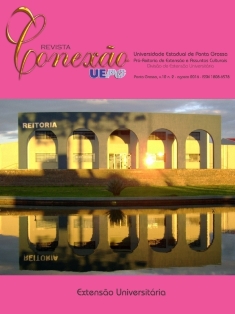A IDENTIDADE VISUAL DOS ALUNOS DO Cap-UERJ - DOI: 10.5212/Rev.Conexao.v.12.i2.0011
DOI:
https://doi.org/10.5212/Rev.Conexao.v.12.i2.0011Parole chiave:
Cultura visual, Identidade, Contemporaneidade, Ensinos fundamental e médio, Rio de Janeiro.Abstract
O Projeto de Extensão O CAp-UERJ e suas impressões visuais amplia as articulações crítico-estéticas acerca da disciplina curricular de Artes Visuais e História da Arte, vinculado ao Departamento de Educação Artística - DEFA. Cadastrado no Departamento de Extensão da Universidade do Estado do Rio de Janeiro - UERJ desde o ano de 2015, o Projeto estuda a identidade visual dos alunos do ensino fundamental ao ensino médio no Instituto de Aplicação / CAp-UERJ a partir do levantamento dos objetos estéticos recorrentes no espaço escolar e relevantes para a formação crítico-cultural. Ao expandir as recorrências estéticas na historiografia da arte e a sintaxe visual nos objetos de uso pessoal (tais como mochilas, tênis, estojos, cadernos etc.) do cotidiano escolar, o Projeto desenvolve a pesquisa visual e a experimentação plástica ao propor a criação de novas padronagens condizentes com a formação identitária e cultural dos alunos no panorama carioca.Downloads
Downloads
Pubblicato
Fascicolo
Sezione
Licenza
a) Os autores mantêm os direitos autorais e concedem à revista o direito de primeira publicação, com o trabalho simultaneamente licenciado sob a Creative Commons Attribution License que permite o compartilhamento do trabalho com reconhecimento da sua autoria e publicação inicial nesta revista.
b) Ao submeter um artigo à Revista Conexão UEPG e tê-lo aprovado os autores concordam em ceder, sem remuneração, os seguintes direitos à Revista: os direitos de primeira publicação e a permissão para que a Revista redistribua esse artigo e seus metadados aos serviços de indexação e referência que seus editores julguem apropriados.
c) Os leitores são livres para transferir, imprimir e utilizar os artigos publicados na Revista, desde que haja sempre menção explícita ao(s) autor (es) e à Revista Conexão UEPG e que não haja qualquer alteração no trabalho original. Qualquer outro uso dos textos precisa ser aprovado pelo(s) autor (es) e pela Revista.

Este obra está licenciado com uma Licença Creative Commons Atribuição 4.0 Internacional.





